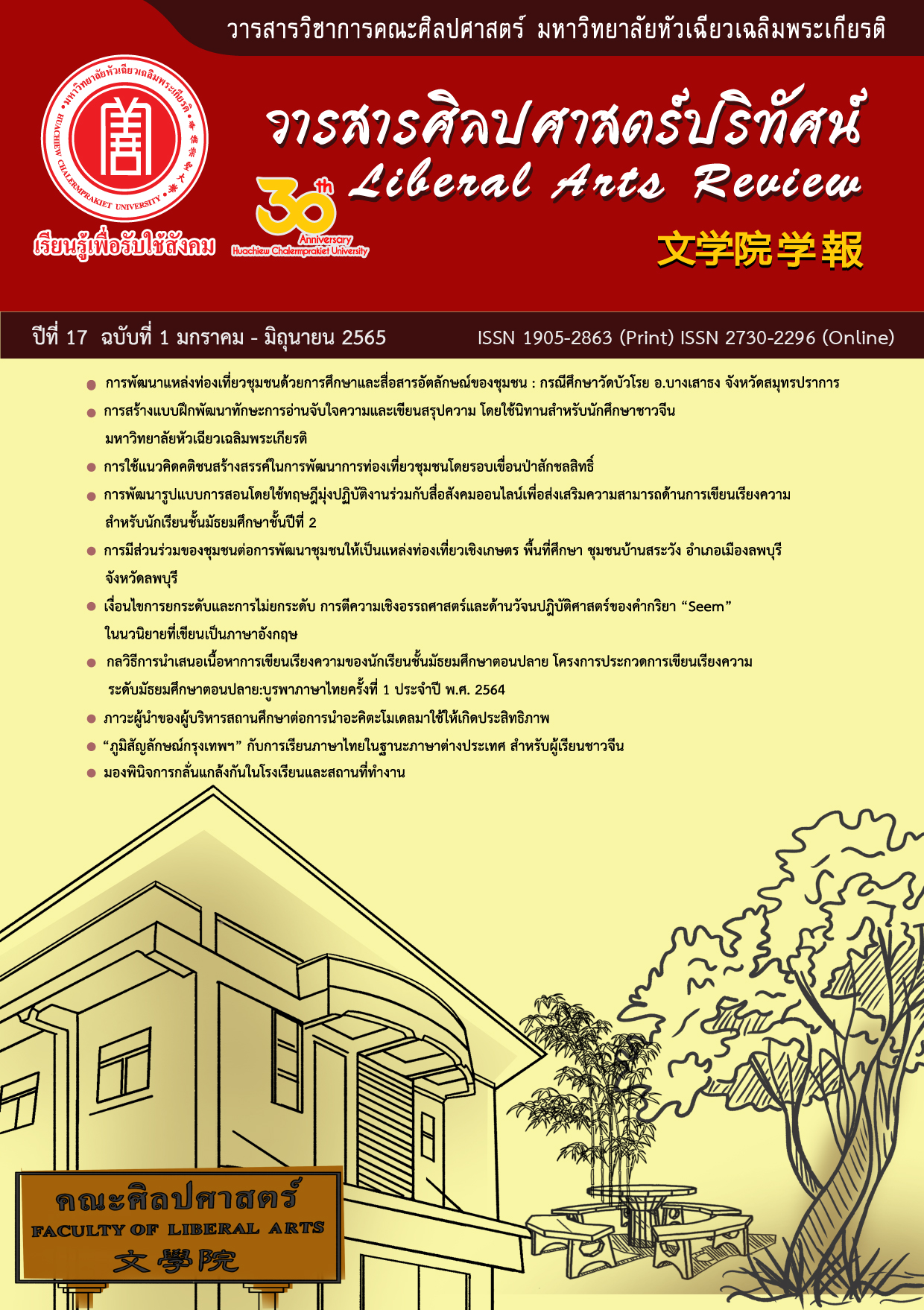Using Thai folktales to improve Chinese students’ reading and writing skills
DOI:
https://doi.org/10.14456/lar.2022.2Keywords:
Drill patterns, Reading for main ideas, Writing summary, FolktalesAbstract
This research project looks at the use of Thai folktales to improve Chinese students’ reading and writing skills in Thai language at Huachiew Chalermprakiat University. The research shows that when students learn from 10 drill patterns that improve reading and writing skills, their learning achievements are greater. For example, it helps students learn how to read for main ideas and how to write summaries. The research shows that students become more efficient at these skills. Moreover, Thai folktales make reading enjoyable. Both children and adults love reading and listening to tales. Apart from readers’ pleasure, Thai folktales offer other advantages, such as improving language skills by focusing on the use of words, proverbs, and thoughts. Thus, Thai folktales are a very useful tool for developing Chinese students’ Thai language skills, particularly for beginners. At all levels, the study of Thai fairy tales increases students’ endurance, loyalty, passion, interest, and good attitudes when learning the Thai language.
References
Choocheun, D. (2005). Activities to develop writing summary skill from reading Thai learning group by using mind map of Primary Education year 5 (Prathomsuksa 5). (Thesis for Master of Education). Graduate School Ratchabhat Phuket University, Phuket.
Karnsaard, C. (2004). Drill Pattern of analysis reading for Students in Secondary school Year 4 (Matthayomsuksa 4) Mahasarakham University Laboratory School. (Thesis for Master of Arts). Graduate School Mahasarakham University, Mahasarakham.
Kensakoo, C. (2005). Development of learning program in analysis reading by folk tales “Pha Deang Nang Ai” for students in Secondary school Year 3 (Matthayomsuksa 3). (Thesis for Master of Arts). Graduate School Mahasarakham University, Mahasarakham.
Mansethawit, S. (2002). Reading Thai Teaching Principle and Methods. Bangkok: Thaiwattanapanit.
Minisrty of Education. (2001). Learning Substance and Standards of Thai Learning Group. Bangkok: Karn Sasana printing.
Minisrty of Education. (2002). Learning Substance and Standard of Thai Learning Group Manual. Bangkok: Suksaphan and printing.
Na Chiangmai, C. (2004). Use of Mind Map to enhance the capability in English reading and writing summary of Students Secondary school Year 4 (Matthayomsuksa 4). (Thesis for Master of Arts). Graduate School Chiangmai University, Chiangmai.
Saengphakdee, K. (1997). Use of drill pattern in writing summary of prose with students in secondary school year 1 (Mathayomsuksa 1) Baan Moh “Pattananukul” School, Saraburi. (Thesis for Master of Arts). Graduate School Khonkaen University, Khonkaen.
Sathornsamritphon, S. (2006). Thai for Career 1. Bangkok: Art Ley Press.
Suriyakarn, P. (2001). Use of Thai Fables as tools in Developing Diphthong Lound-Reading for Students Primary Education year 2 (Prathomsuksa 5) in Schools under Office of Primary Education Commission, Amphur Bangrachan, Sukhothai. (Thesis for Master of Arts). Graduate School Sukhothai Thammathirat University, Nonthaburi.
Thiplai, K. (2002). Drill Pattern of Writing Summary from Prose in Students Prathomsuksa 5 by using mind map. (Thesis for Master of Education). Graduate School Taksin University, Songkhla.
Downloads
Published
How to Cite
Issue
Section
License
Copyright (c) 2022 Liberal Arts Review

This work is licensed under a Creative Commons Attribution-NonCommercial-NoDerivatives 4.0 International License.
บทความที่ได้รับการตีพิมพ์เป็นลิขสิทธิ์ของวารสารศิลปศาสตร์วิชาการและวิจัย
ข้อความที่ปรากฏในบทความแต่ละเรื่องในวารสารวิชาการเล่มนี้เป็นความคิดเห็นส่วนตัวของผู้เขียนแต่ละท่านไม่เกี่ยวข้องกับมหาวิทยาลัยหัวเฉียวเฉลิมพระเกียรติ และคณาจารย์ท่านอื่นๆ ในมหาวิทยาลัยฯ แต่อย่างใด ความรับผิดชอบองค์ประกอบทั้งหมดของบทความแต่ละเรื่องเป็นของผู้เขียนแต่ละท่าน หากมีความผิดพลาดใดๆ ผู้เขียนแต่ละท่านจะรับผิดชอบบทความของตนเองแต่ผู้เดียว




